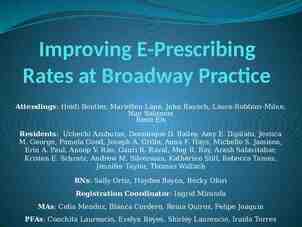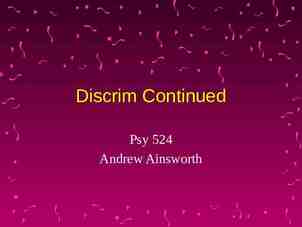Voluntary Guidelines for Managing Food Allergies in Schools and Early
15 Slides3.17 MB
Voluntary Guidelines for Managing Food Allergies in Schools and Early Care and Education Programs
Objectives Describe the symptoms of food allergies and lifethreatening reactions. Identify three actions to help support the daily management of students with food allergies. Identify two ways to support healthy and safe classrooms and schools for students with food allergies. 2
Overview The guidelines can help schools manage the risk of food allergies and severe allergic reactions in students. Managing food allergies requires a partnership between families, health care providers, and schools. 3
Did you know? In a classroom of 25 students, at least 1 student is likely to be affected by food allergies. Students with food allergies may experience more anxiety and fear than their nonallergic peers. More than 1 of 3 people with food allergies report being the victims of bullying, teasing, or harassment because of their food allergy. 4
What can you do? Plan! Know your school district’s food allergy policies and rules. Know your school’s Food Allergy Management and Prevention Plan. Become familiar with student emergency care plans. 5
What can you do? Get trained! Participate in training and review resources. Know the signs and symptoms of food allergies and how to respond in an emergency. 6
What can you do? Learn about food allergies! A food allergy is an adverse immune system reaction that occurs soon after exposure to a certain food. Any food can cause a food allergy, but most are caused by milk, eggs, fish, shellfish, wheat, soy, peanuts, and tree nuts. A severe life-threatening allergic reaction is called anaphylaxis. 7
What can you do? Recognize food allergy symptoms! Food allergy symptoms can include Swollen lips, tongue, or eyes. Itchiness, rash, or hives. Nausea, vomiting, or diarrhea. Congestion, hoarse voice, or trouble swallowing. Wheezing or difficulty breathing. Dizziness, fainting, or loss of consciousness. Mood change or confusion. 8
What can you do? If you suspect anaphylaxis 1. Activate the student’s Food Allergy Management and Prevention Plan and contact the school nurse or administrator. 2. Be ready to administer an epinephrine auto-injector if you are delegated and trained to do so. 3. Call 911 or the emergency medical system immediately. All students with anaphylaxis must be monitored closely and evaluated as soon as possible in an emergency care setting. 9
What can you do? Help with the daily management of students with food allergies. Provide assistance with the development of a Section 504 or an Individualized Education Program, if needed. Address immediate and long-term mental health problems, such as anxiety, depression, social isolation, and stress. Help connect families with community health providers and resources. 10
What can you do? Support a healthy and safe school environment for students with food allergies. Support other school health professionals by providing training and education for staff and parents on the mental and emotional health issues faced by students with food allergies. Report all bullying to the administrator. Work with parents, classroom teachers, and other school staff to prevent bullying and discrimination against students with food allergies. 11
Where can you find more information? Centers for Disease Control and Prevention. Voluntary Guidelines for Managing Food Allergies in Schoo ls and Early Care and Education Programs . 2013. Available at www.cdc.gov/healthyyouth/foodallergies/ National Association of School Psychologists: Available at http://www.nasponline.org/resources/bullying/index.asp 12
Questions ? 13
References 1. Branum AM, Lukacs SL. Food allergy among U.S. children: trends in prevalence and hospitalizations. NCHS Data Brief. 2008;10:1-8. 2. Liu AH, Jaramillo R, Sicherer SH, et al. National prevalence and risk factors for food allergy and relationship to asthma: results from the National Health and Nutrition Examination Survey 20052006. J Allergy Clin Immunol. 2010;126(4):798-806.e13. 3. Cummings AJ, Knibb RC, King RM, Lucas JS: The psychosocial impact of food allergy and food hypersensitivity in children, adolescents and their families: a review. Allergy. 2010;65:933-945. 4. Lieberman J, Weiss C, Furlong TJ, Sicherer SH. Bullying among pediatric patients with food allergy. J Allergy Clinical Immunol. 2010;105:267-271. 5. Ravid NL, Annunziato RA, Ambrose MA, et al. Mental health and quality-of-life concerns related to the burden of food allergy. Immunol Allergy Clin N Am. 2012:32(1):83-95. 6. Nowak-Wegrzyn A, Conover-Walker MK, Wood RA. Food-allergic reactions in schools and preschools. Arch Pediatr Adolesc Med. 2001;155(7):790-795. 7. McIntyre CL, Sheetz AH, Carroll CR, Young MC. Administration of epinephrine for life-threatening allergic reactions in school settings. Pediatrics. 2005;116(5):1134-1140. 8. Sicherer SH, Furlong TJ, DeSimone J, Sampson HA. The US Peanut and Tree Nut Allergy Registry: 9. Houle CR, Leo HL, Clark NM. A developmental, community, and psychosocial approach to food allergies in children. Curr Allergy and Asthma Rep. 2010;10(5):381-386 14
Thank You 15




















